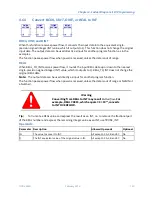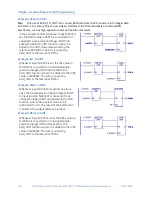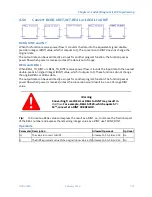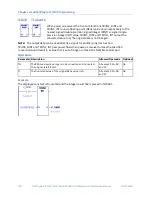
Chapter 4. Ladder Diagram (LD) Programming
GFK-2950C
February 2018
117
4.5.8
Suspend I/O
The Suspend I/O (SUS_IO) function stops normal I/O scans from occurring for one CPU
sweep. During the next output scan, all outputs are held at their current states. During the
next input scan, the input references are not updated with data from inputs. However,
during the input scan portion of the sweep, the CPU verifies that Genius bus controllers have
completed their previous output updates.
Note:
The PACSystems SUS_IO function suspends analog and discrete I/O, whether integrated I/O
or Genius I/O. It does not suspend Ethernet Global Data. For details, refer to
PACSystems
RX7i, RX3i and RSTi-EP TCP/IP Ethernet Communications User Manual,
GFK-2224.
When SUS_IO receives power flow, all I/O servicing stops except that provided by DO_IO functions.
Warning
If SUS_IO were placed at the left rail of the ladder,
without enabling logic to regulate its execution, no
regular I/O scan would ever be performed.
SUS_IO passes power flow to the right whenever it
receives power.
Example
The example at right shows a SUS_IO function and a
DO_IO function used to stop I/O scans, then cause certain
I/O to be scanned from the program.
Inputs %I00010 and %I00011 form a latch circuit with the
contact from %M00001. This keeps the SUS_IO function
active on each sweep until %I00011 goes on. If this input
were not scanned by DO_IO after SUS_IO went active,
SUS_IO could only be disabled by powering down the PLC.
Output %Q00002 is set when both DO_IO functions
execute successfully. The rung is constructed so that both
DO_IO functions execute even if one does not set its OK
output. With normal I/O suspended, output %Q00002 is not
updated until a DO_IO function with %Q00002 in its range
executes. This does not occur until the sweep after the
setting of %Q00002. Outputs that are set after a DO_IO
function executes are not updated until another DO_IO
function executes, typically in the next sweep. Because of
this delay, most programs that use SUS_IO and DO_IO
place the SUS_IO function in the first rung of the program,
the DO_IO function that processes inputs in the next rung,
and the DO_IO function that processes outputs in the last
rung.
The range of the DO_IO function doing outputs is %Q00001
through %Q00030. If the module in this range were a 32-point
module, the DO_IO function would actually perform a scan of the
entire module. A DO_IO function will not break the scan in the
middle of an I/O module.
Summary of Contents for PACSystems RSTi-EP
Page 357: ......
Page 466: ...Chapter 9 Diagnostics GFK 2950C February 2018 451 ...
















































